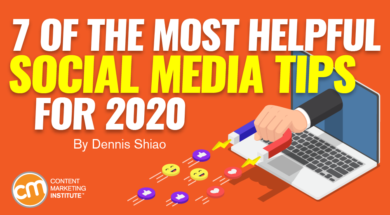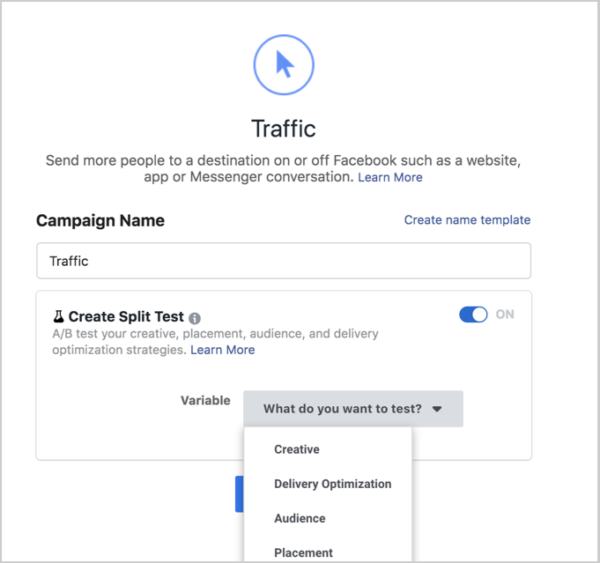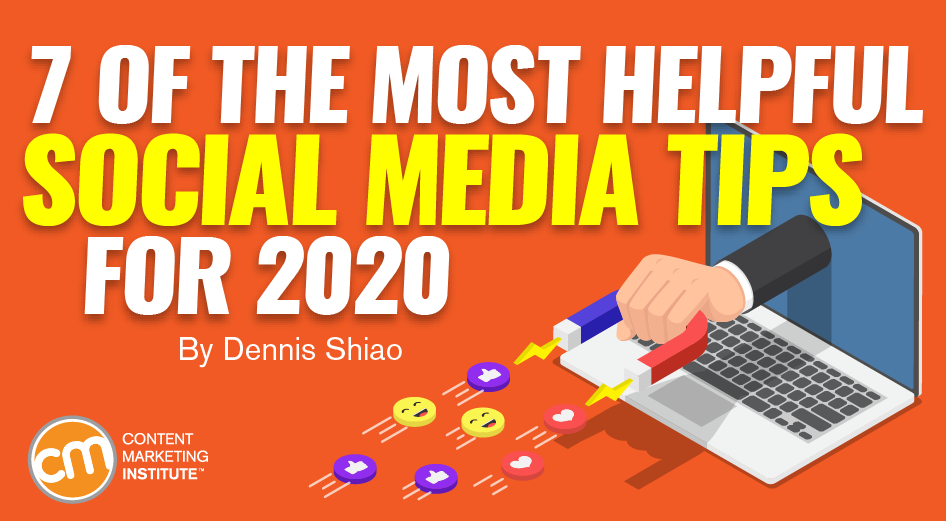
A badge of honor is displayed on my Twitter profile: I joined in December 2007. Back then, we were still at 140 characters and link shortening tools didn’t exist. Retweets and replies were manual. That’s right: To retweet someone, you had to type “RT @[user],” then copy and paste their tweet.
Not the new kids on the block, Twitter and Facebook are teenagers. And Instagram? It is 10 this year.
Pick any social platform and you’ll find that as it grows older users come and users go. New features are launched, while other features are removed. As these platforms age, it can be challenging to figure out how your business brand or personal brand can get the most out of them.
To help, I reviewed CMI’s 2019 posts on social media marketing and came away with some key insights for one-stop reading.
1. Instagram: hashtag strategy + fan engagement
Jodi Harris shares Instagram tips from Wally Koval, former CMI team member, Content Marketing World presenter, and owner of the popular Instagram account @AccidentallyWesAnderson. On the Instagram account (857,000 followers), Wally shares photos and commentary that recall the visual style of Wes Anderson’s films.
Though some Instagram users use up to 30 allowed hashtags in a post, Wally recommends creating an intentional hashtag strategy.
As Jodi writes, “Wally says pursuing too many audiences at once will dilute your content’s impact and diminish returns. He recommends aiming for five to 10 of the most relevant hashtags – including two or three unique to your brand.”
Use 5-10 of the most relevant hashtags on @Instagram, says @accidentallywa via @cmicontent. #socialmedia Click To TweetTwo other social media tactics from Wally caught my eye. First, the comments showed him that fans wanted to contribute their ideas, which led Wally to invite them to submit their photos for posting consideration.
Next, Wally chose to forgo automation (e.g., Instagram scheduling tools) so he could be present to respond to comments right away. If you are a fan of a popular Instagram account and receive a quick reply to your comment, you’re probably going to pay more attention and be more likely to comment again.
2. Organic data can inform paid social strategy
CMI’s 2020 B2B Benchmarks, Budgets, and Trends – North America found that 72% of B2B marketers used social media advertising in the past 12 months. This was the most cited category of all paid content distribution channels, exceeding sponsorships (66%) and search engine marketing (61%).
Ann Gynn recommends a data-driven approach to social advertising. First, evaluate the traffic coming to your site from organic social media traffic. It’s like having your own focus group. For instance, if a blog post is getting a lot of traffic from Twitter, then it would be a good idea to run Twitter ads to give that post a further boost.
Organic #socialmedia traffic can be your focus group for your paid social media strategy, says @AnnGynn via @cmicontent. Click To TweetIn other words, use the data from organic social posts to inform your paid post strategy. “Instead of spending a little on everything, you can spend more on the content pieces most likely to drive your desired results,” writes Ann.
3. Facebook ad placement and your campaign objective
At the beginning of his CMI post, Brad Smith writes, “Facebook Pages with over 500,000 ‘likes’ have an average organic reach of 2% or less for each post, according to research from Social@Ogilvy reported by HubSpot.”
Facebook Pages w/ over 500K 'likes' have an average organic reach of 2% or less. @Ogilvy #research @hubspot via @cmicontent. Click To TweetBrad’s post was published at the beginning of the year. By now, I wouldn’t be surprised if average organic reach was even lower. What’s one way to combat that downward trend? Facebook Ads. To reach your target audiences on Facebook, you need to spend money on Facebook advertising.
You can run Facebook campaigns to attract and convert them, but the question becomes are you making the most of your investment? You can if you follow Brad’s tip – select ad placements that align with your campaign objective.
To make the most of your #Facebook investment, select ad placements that align with your campaign objective, says @bsmarketer via @dshiao @cmicontent. Click To TweetFor example, to drive traffic to a blog post (i.e., a low-value conversion in your content marketing strategy), a News Feed ad may not be worth the cost. As Brad writes, “Facebook News Feed placements often come at a premium. They’re front and center, where people can’t miss them. That makes them great for conversion-based campaigns. However, they don’t make as much sense for content promotion for the same reason: You’re overpaying for what you need.”
4. Swipe-up link at 10,000 followers on Instagram
I have an Instagram account, but use it far less than Twitter. I classify myself as a novice on Instagram.
In Susan Moeller’s post about Instagram, I had an aha moment when I read, “The good news is accounts with at least 10,000 followers can give viewers of their stories the ability to swipe up for a link.”
With 10,000 followers on #Instagram, you get a swipe-up link option, says @SusanCMoeller via @cmicontent. #socialmedia Click To TweetThere is a way to share links on Instagram! You just need to get 10,000 followers. Hmm. Well, Susan’s post provides a great strategy on how to get there – the VALUE framework:
- Valuable: Helpful or educational content from which your audience can learn
- Aspirational: Idealized, tangible content to help attain a vision or a goal
- Lifecycle: Content builds awareness, nurtures relationships, or encourages action
- Unique: Proprietary and branded content focused on your business
- Evergreen: Timely, relevant, and useful content for years to come
Susan recommends that users think in batches of nine since Instagram shows the nine most recent posts on your profile. Shen writes, “Think about it this way: If someone finds one of your Instagram posts due to a hashtag search and taps to see the rest of your profile, will they be impressed?”
Susan shared an approach that Mike Allton uses, creating a checkerboard pattern that alternates black and white images on his profile. I love it.

5. Response to disappearance of ‘likes’
Almost a year ago, Instagram tested the removal of “front-facing likes” in Australia. Recently, it rolled out this update to users in the United States. CMI’s Ann Gynn was prescient, writing a post earlier about how to think about – and respond to – this change.
While you may get the warm fuzzies from seeing high “like” counts on your post, ultimately, a click on the “like” button doesn’t mean a whole lot. It’s an unclear signal. Did someone “like” your post as a way of bookmarking it? Was it a bot that “liked” your post? You don’t know the why of a “like.” You do, however, get more context when someone replies. You get their opinion and their point of view. For public validation of your content, Ann recommends these alternatives to “likes”:
- Curate blog posts based on comments to social media posts.
- Publish testimonials on your social media platforms..
- Encourage more interaction on your blog in the comments section by asking readers for their thoughts.
We discussed “likes” as part of a wider conversation on engagement in the Chief Content Officer magazine feature Talking Points last fall.
6. Split test of Facebook Ads
Several years ago, I ran split-testing tools on websites and managed Facebook Ads campaigns. Until reading Dmitry Dragilev’s post, I didn’t know that you can run split tests directly in Facebook Ads Manager:
Run A/B tests on your #Facebook ad when promoting content. Facebook’s Ads Manager has a split-testing feature that handles this for you, says @dragilev via @cmicontent. #socialmedia Click To Tweet
Dmitry shared advice from Gaetano DiNardi of Nextiva – don’t test everything at once. Instead, use split testing to find your winning text. Then, use testing to find the winning creative. Put them together to get a win-win combination.
When doing A/B testing, it is important that you don’t test everything at once, says @gaetano_nyc via @cmicontent. #FacebookAds Click To TweetIn addition, make sure you get meaningful results. Dmitry writes, “Don’t end the split test before you have had enough time to collect results. Similarly, don’t test it too long to the point where you’re wasting money. The stop point varies by campaign; just use your common sense.”
HANDPICKED RELATED CONTENT:
7. Live videos in your social media marketing mix
Joe Forte encourages brands to broadcast live video on social media.
“Live videos often are most effective for announcements, behind-the-scenes looks, and product information videos,” he writes. Before jumping in, Joe recommends you get the logistics right: technology, lighting, sound, etc. He also suggests you promote your livestreams ahead of time and broadcast at the same time each week.
Promote your livestreams ahead of time & broadcast at the same time each week, says @realjoeforte via @cmicontent. #socialmedia Click To TweetAt Content Marketing World, Brian Fanzo spoke about the virtues of live video – it helps you be transparent and relatable, making you stand out in a crowd of content.
HANDPICKED RELATED CONTENT:
Let’s get social
Enough summarizing for me and enough reading for you. Let’s get social. Share with us your top takeaway for social media marketing this year and how you plan to apply that takeaway in the coming year.
Also, let me know what I missed. What post on social media resonated with you this year? Let me know in the comments.
HANDPICKED RELATED CONTENT:
Connect with the CMI community on Facebook, Slack, Twitter, and LinkedIn. And join us at 12 p.m. U.S. Eastern time Tuesdays for our Twitter Chat (#CMWorld).
Cover image by Joseph Kalinowski/Content Marketing Institute

